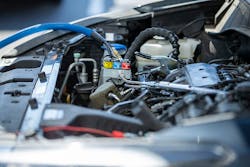- Some intake designs are not conducive to walnut cleaning. Walnut shells can become trapped and interfere often unnoticed before assembly and restart. Catastrophic damage may be the result.
- Proper knowledge of walnut cleaning is necessary. Spend careful attention to close each valve so walnuts do not fall down into the cylinder. This situation will also cause irreparable damage.
- Sometimes it is the only way due to engine design or manufacturer specification. Be prepared for all scenarios when going in.
What other options are there?
Manually cleaning by hand or by soaking with chemicals offer no time benefit (when compared to walnut shell blasting) and are less effective. Some of these chemicals can be harsh and destructive to rubber seals on the valve stem and other surrounding components.
Non-intrusive chemical cleaning removes all the associated risks of engine tear down, manual scrubbing, and unforeseen repairs resulting in intake removal. Until now, there hasn’t been a system that could actually clean carbon build-up from the back of intake valves. The 3C Intelligent Induction Cleaner (IIC) uses triple chemical layering, delivered by micro-burst and air injection technology to more effectively remove carbon build-up from engines.
The ATS 3C IIC system saves time and money for both the shop and the vehicle owner while helping to maintain the performance of GDI engines. The 3C carbon cleaning machine does not require engine disassembly (intake manifold removal). This means you won’t have the additional labor charge of the repair or the costs for parts and gaskets. With the intake manifold staying in place, you remove the risk of damaging fragile vapor and vent lines as well as plastic connectors and components.
3C makes quick work of carbon and cleans most cars in less than 15 minutes.
Here’s how: the 3C Carbon Clean System connects to the engine via the purge valve vacuum line. Once connected, carbon is cleaned through a 3-step chemical cleaning process. All automated, all catalytic converter and engine safe. No soaking or manual scrubbing is needed, so seals and other rubber components are not affected during the cleaning.
The 3C cleans heavy carbon deposits, as well as helps to prevent carbon build-up. When the service is performed every 30,000 miles, carbon build-up is removed before it becomes a major problem.



